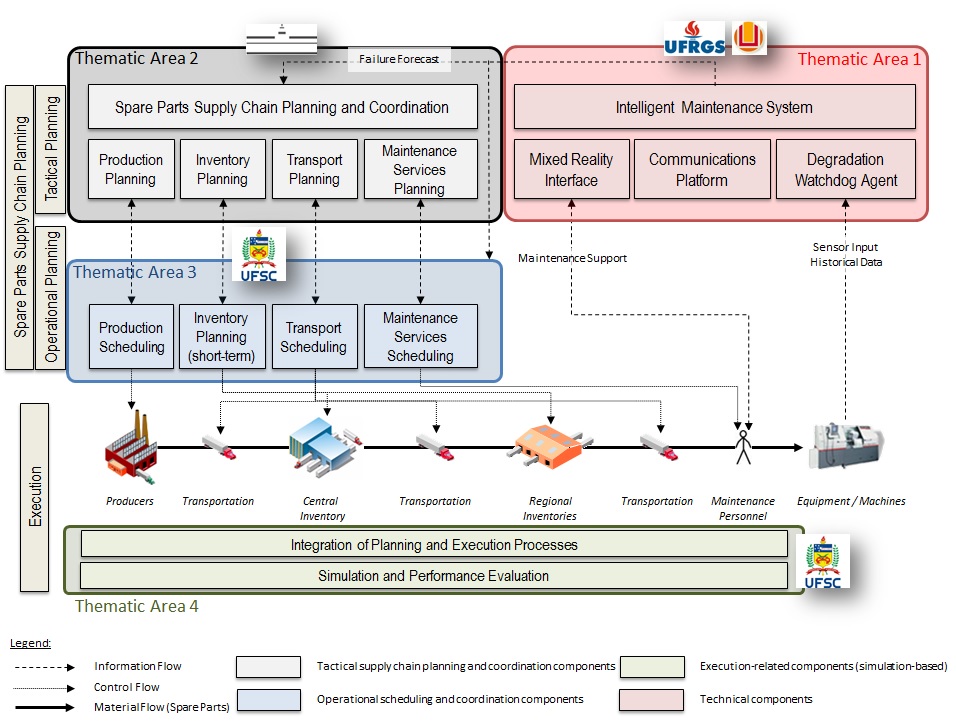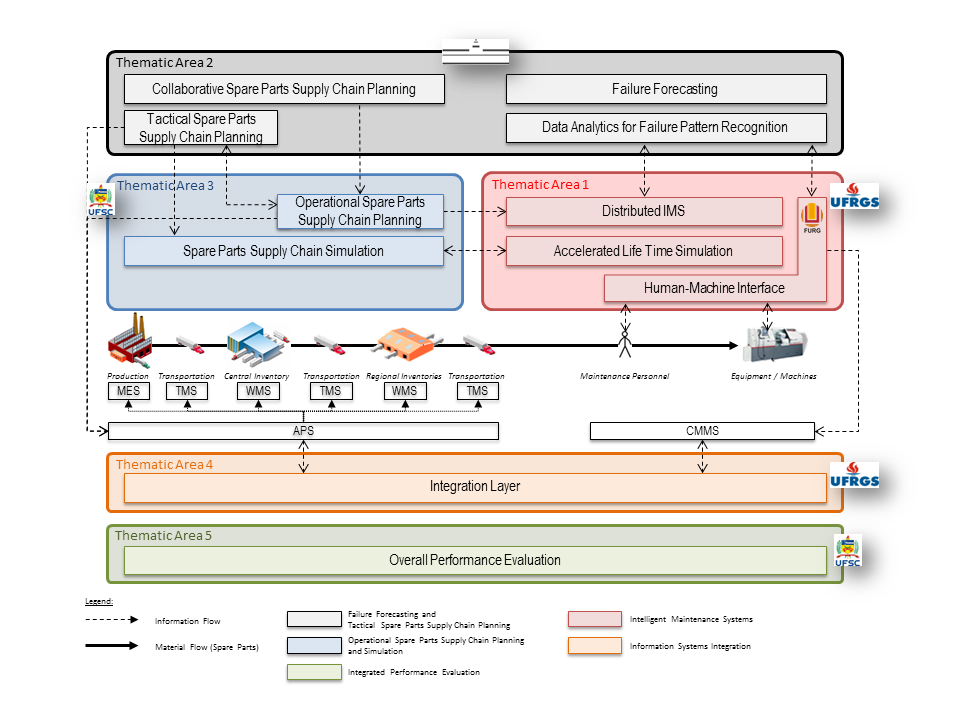Phase 1
Phase one of the project included researching Intelligent Maintenance Systems (IMS) and Spare Part Supply Chain (SPSC) management. The high-level view of the project concept could be specified into four “thematic areas” with respect to both perspectives: IMS technology as well as spare parts supply chain planning and coordination. All thematic areas have been interdependent and consolidated in an integrative solution. Several work packages were assigned to each area.

The IMS developed during the first phase was developed specifically for a unique part used in the oil industry. Gear degradation was detected using linear regression and then rest of life was calculated using an auto-regression moving average model (ARMA). The current IMS was trained with laboratory data in the pre-operation phase regarding failure detection. However, with this method, external factors are hard to predict and reproduce in the laboratory. A possible improvement to the system would be to use principles from Artificial Immune Systems (AIS) which would generate a distributed IMS (dIMS) making it capable of adapting to unknown conditions by utilizing a collaborative diagnostic process. The algorithm developed for this IMS was developed using artificial intelligence and statistical regression, which requires a difficult to obtain data set. Current methods to obtain the necessary data include replacing a functional part with a damaged one and collecting data on its operation. A better way to collect data for this would be to use an accelerated life test which would allow the part to age in a shorter amount of time, thus giving data on the degradation process and not just the operation of a part in its end degradation state. In addition, AIS can be further improved by using simulations to collect product data over the entire life cycle. Finally, for this phase, human interaction was tested by utilizing augmented reality techniques which allowed maintenance personnel to access the appropriate data at the right time thus improving maintenance operations by alerting technicians to part degradation.
From the monitoring data provided by the IMS described previously, the quality of demand forecasting for spare parts has risen thus enabling improved spare parts supply chain planning by devising advanced technical methods for tactical and operational planning. One limitation of this research in phase one however was that it has not been able to research how large volumes of machine status data can be collected and analyzed for further improvement in failure forecasting and pattern detection brought about by design and environment changes. This could be corrected by implementing a dIMS and collecting data from the service technicians themselves who might have unique insights not collectable by machine.
In addition, phase one of this project has developed a Framework for Intelligent Supply Chain Collaboration (FRISCO) which enables the design and evaluation of collaborative planning concepts in hierarchical spare parts supply chains. This framework has been tested and proven promising results thus meriting future research into more sophisticated planning concepts and SPSC evaluation.
Finally, in this phase, a procedure to integrate technical condition information into the operational planning system of a SPSC has been proposed and tested. This procedure uses mathematical programming and simulation based sensitivity analysis and was verified through the development of a proof-of-concept in lowering total costs while ensuring service levels in regard to order delivery in a specified period of time. In order to implement this framework research on components and coupling strategies need to be researched further.
For phase one, two industrial evaluation cases were utilized, one, a Brazilian manufacturer of automation solutions for the oil industry and the other, a German company manufacturing elevators and escalators on a global scale. In addition, in phase two a third case was added focusing on a company that produces hydraulic systems for both the German and Brazilian market.
Phase 2
The primary objective of phase two was to improve the effectiveness and efficiency of SPSC management activities for complex technical systems by further integrating advanced IMS technologies. This provides information utilized in new methods from data analytics and supply chain planning as well as information from already developed solutions. Research work in this phase focused on the after-sales section of the product life cycle and evolving technologies and methods for enhancing product usage, repair, and all other activities along the SPSC. Phase two was divided into five thematic areas:

Thematic Area 1 developed a distributed information management system that enables data sharing about machines being monitored based on the artificial immune system paradigm. In addition, an accelerated life time simulation of the whole machine based on the information provided from the dIMS was developed. Developing this system improved forecasting for machine failures and was the basis for defining the web based HMI that collects and provides data to and from service technicians which integrate human knowledge into the IMS.
Thematic Area 2 aimed to better utilize data analytics methods based on data provided by the dIMS and HMI described in Thematic Area 1, which identify general failure patterns in a particular set of machines. In addition, forecasting methods for machine failures and spare parts have been improved and feed back into the dIMS and HMI. Continuing, this theme also focused on the enhancement of the tactical scope of the SPSC planning domains, with the integration of production and maintenance service planning into current planning approaches being the foci.
Thematic Area 3 focused on the operational planning framework previously realized. In this phase it was enhanced by adding alternative methods for solving the developed integrated planning model and considering different approaches to control the framework and couple its elements. A second goal of this theme was to extend the existing simulation environment for evaluating the achieved results from the SPSC management perspective of the research project. This was coupled with the accelerated life time simulation described in Thematic Area 1 and provides an integrated view of machines and supply chain behavior.
Thematic Area 4 focused on developing a technological and conceptual framework for an integration layer that connects the different involved and applied information systems for maintenance, planning and controlling the SPSC. The different systems are integrated using a service oriented architecture (SOA).
Thematic Area 5 integrated all the results from the previous four thematic areas and allows for an overall evaluation of the I2MS2C concept. Evaluation was based on three industrial cases. Simulation based evaluation explored the concept for different SPSC scenarios and allowed for comparison between German and Brazilian SPCS concepts.


